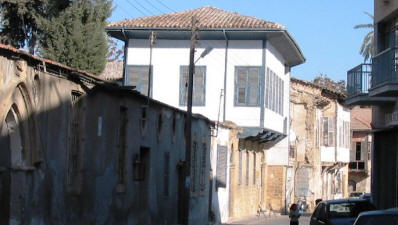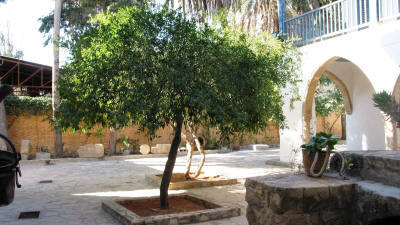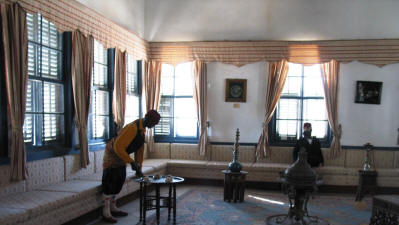Dervish Pasha Mansion
Nicosia, North Cyprus
 |
| The Dervish Pasha Mansion |
The Dervish Pasha museum is located in Belig Pasha Street in the Arabahmet area of Nicosia. It is not dissimilar in style and content to the Hadjgeorgakis Kornesios Mansion in the south of the city. Built in the early 19th century, it has two entrances, one of whish has the date 1807.
The owner was Dervish Pasha, the editor of Zaman, the first Turkish newspaper in Cyprus. The newspaper was first published on the 25th December 18891, and as time passed, it was widely read in Mainland Turkey. Dervish Pasha, whose actual name was Tuccarbasi Haci Dervis was a leading figure in the Turkish Cypriot community, and a member of the assembly that ratified the decisions of the British colonial administration. (Although the truth of the matter was that the assembly had no choice.) Because of this he was granted the courtesy title of "Mir-i Miran", a Pasha who governs a province.
 |
| The Courtyard |
The mansion is a fine example of Ottoman architecture. The whitewashed walls, plain yellow-stoned arches, terracotta roof and blue woodwork are all typical. It is built on two floors, the first in stone and the second in mud brick. The main room, which was an extension, is timber-framed with stone filling.
The L-shaped mansion has a spacious inner yard which has a well, a washroom, an outdoor oven, and even a bathhouse. These rooms still have to be renovated, and only the walls exist. The doors of the ground floor rooms open to galleries surrounding the inner garden. At the entrance there is a room that was traditionally used to entertain male visitors away from the residential quarters. This has been converted into a small cafe.
 |
| TheMain Room of the Mansion |
Other ground floor rooms are arranged as a kitchen displaying Turkish metal ware and plain glazed ceramics. A second room is furnished with a central charcoal brazier, a household loom and a loom. The third room has items relating to the culture of the Ottoman empire. The open downstairs hall has a display of Cypriot agricultural tools. It also has some tables and chairs for you to relax on, perhaps with a cup of Turkish coffee from the cafe.
The ground floor was devoted to the administration of the household, while the private apartments were on the first floor. These were approached via a staircase from the courtyard, leading onto a veranda, which in turn leads to the private rooms, where there are further ethnographic displays of a bridal room and a bedroom.
The main room, extending over the street, is different in style to the others, having a painted ceiling and the minimum of furnishing.
For a long time the mansion was neglected, and it fell into a state of some disrepair. However in 1978 it was nationalised. Over the next ten years it was gradually restored. Initial plans were to use the mansion as a library, cultural centre, or as the headquarters of the Antiquities Department. These plans, however, were abandoned, and the mansion opened as an ethnographic museum on the 21st march 1988.
See location in Google maps.
Back to Nicosia Index.